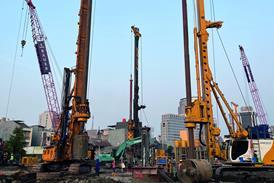Everyone knows we鈥檙e not building enough houses, but have ministers really got their heads round the scale of the problem? The sums do not make pretty reading
Just how much trouble are we in?
Yvette Cooper, the Minister for Housing and planning, is proud that Britain鈥檚 average housing density is 39 dwellings a hectare, up from just 25 in 1997, and that 67% of new dwellings are being built on brownfield land, compared with 57% in 1997. But she is still worried that not enough flats, rather than houses with gardens, are being built on urban infill sites. So worried that she is consulting on how the planning system can be more 鈥渕arket oriented鈥�.
The ODPM proposes that planning should now be about:
- Taking account of the market Regions will continue to distribute housing provision but will use subregional housing markets as a basis for decisions as well as other factors. The plan horizon will extend to 15 years.
- Identifying land for housing The first five years鈥� worth of land will be allocated and developable.
- Plan, monitor and manage The five-year supply will be rolled forward as land is developed with local authorities required to bring forward land from their 10-year stock to ensure available supply is maintained.
That sounds like all the land that is needed for household growth will be made available on demand. But what if those households demand homes with gardens? They can鈥檛 have them because that would mess up the ODPM鈥檚 figures. Nor have they really thought through what they mean by 鈥渢he market鈥�.
Britain鈥檚 population of 57 million lives in a housing stock comprising about 24 million dwellings. We might estimate that by 2030 a Britain of 64 million will need a stock of about 27 million homes if household growth were to match population growth. But households are getting smaller and more are needed than population growth alone would suggest. It seems reasonable to estimate household numbers at 29 million by 2030. The Centre for Economics and Business Research (www.cebr.com) estimated a little more than that figure five years earlier, but that seems high. That increase of 5 million households means we need at least 200,000 new homes a year over the next 25 years.
Current levels of stock replacement are so low, each home standing today will have to last 1200 years
Then there is the rate of stock replacement. A domestic structure periodically rebuilt as a museum piece will last indefinitely, because resources are being lavished on it. Ordinary flats or houses will just about last 100 years with laborious refurbishment and a lot of DIY. To replace the housing stock as it increases from 24 million to 29 million on an average 100-year cycle requires us to build 242,000 new homes in 2006, incrementally rising to 290,000 in 2030. In 25 years that is a total of 6.6 million homes, or an average of 266,000 every year.
Adding the 200,000 required for annual new household formation and the 266,000 average for stock replacement, Britain requires an average build of 466,000 homes a year over the next quarter of a century. That is a total of 11.6 million over 25 years. This unprecedented housing output must surpass the record number of 413,714 built in 1968, when Harold Wilson鈥檚 Labour government had promised 500,000 in their election manifesto. It also stands in bleak contrast to the low levels of housebuilding achieved by Labour since its 1997 election victory, which averages 171,225 a year.
Of course, the previous record of Conservative administrations was not much better, but it is new Labour that currently presides over an average annual undersupply of about 295,000 homes. On the estimates accepted by the ODPM, there is such a low level of stock replacement involving demolition that each home standing today will have to last 1200 years. The consequence is that the construction sector is stuck with being mainly a site-based refurbishment and DIY business, unproductively patching up dilapidating dwellings. And, of course, that is where the real market for the resale of existing homes is situated.
The CEBR鈥檚 Forecasting Eye predicts that the average UK house price in 2025 will be 拢335,674, compared with 拢163,334 in 2005. This is based on the assumption that the rate of household formation will be restrained by the fact that young people are forced to stay with their parents for longer, or share flats. In other words, they cannot afford a home of their own because the market is not getting enough new development to risk collapsing the speculation in old property.
So, Cooper will listen to the property market, and as a consequence her planners will not be meeting the annual need for 466,000 spacious homes. Don鈥檛 panic 鈥� unless you have children.
Postscript
Ian Abley is an architect and runs www.audacity.org




















No comments yet